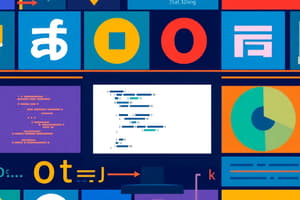Podcast
Questions and Answers
What is the primary characteristic of low-level programming languages?
What is the primary characteristic of low-level programming languages?
- Close to machine language (correct)
- High-level abstraction
- Platform independence
- Interpretive nature
What is the primary function of a decoder in digital circuit design?
What is the primary function of a decoder in digital circuit design?
- To select one of multiple input signals (correct)
- To encode binary data
- To perform arithmetic operations
- To amplify weak signals
What is the primary advantage of denormalization in database design?
What is the primary advantage of denormalization in database design?
- Improved data integrity
- Reduced data redundancy
- Improved data security
- Increased query performance (correct)
What is the primary function of the OSI model in network architecture?
What is the primary function of the OSI model in network architecture?
What is the time complexity of a linear search algorithm?
What is the time complexity of a linear search algorithm?
What is the primary characteristic of a scripting language?
What is the primary characteristic of a scripting language?
What is the primary function of a multiplexer in digital circuit design?
What is the primary function of a multiplexer in digital circuit design?
What is the primary advantage of using a relational database?
What is the primary advantage of using a relational database?
What is the primary function of a router in network architecture?
What is the primary function of a router in network architecture?
What is the primary characteristic of a graph data structure?
What is the primary characteristic of a graph data structure?
Flashcards are hidden until you start studying
Study Notes
Programming Languages
- Types of Programming Languages:
- High-level languages (e.g., Python, Java): abstract, human-readable, and platform-independent
- Low-level languages (e.g., Assembly, Machine code): close to machine language, platform-dependent
- Scripting languages (e.g., JavaScript, Perl): interpretive, high-level, and often used for web development
- Language Characteristics:
- Syntax: rules governing language structure
- Semantics: meaning of language elements
- Type systems: static or dynamic typing, strong or weak typing
- Programming Paradigms:
- Imperative programming: focus on procedures and state changes
- Object-oriented programming: focus on objects and their interactions
- Functional programming: focus on functions and immutability
Digital Circuit Design
- Digital Logic:
- Boolean algebra: mathematical system for representing logic operations
- Logic gates: basic building blocks of digital circuits (AND, OR, NOT, etc.)
- Combinational Logic:
- Circuits with no memory, output depends only on current input
- Examples: arithmetic logic units (ALUs), decoders, multiplexers
- Sequential Logic:
- Circuits with memory, output depends on current and past inputs
- Examples: counters, registers, finite state machines
Database Systems
- Database Types:
- Relational databases (e.g., MySQL): organize data into tables with well-defined schemas
- NoSQL databases (e.g., MongoDB): flexible schema, optimized for big data
- Database Design:
- Normalization: process of organizing data to minimize redundancy and improve data integrity
- Denormalization: process of intentionally denormalizing data for performance gains
- Database Operations:
- CRUD (Create, Read, Update, Delete) operations
- Query languages: SQL, query optimization, and indexing
Network Architecture
- Network Topologies:
- Physical topologies: bus, star, ring, mesh
- Logical topologies: network protocols, packet switching, circuit switching
- Network Protocols:
- OSI model: 7-layered framework for understanding network communication
- TCP/IP model: 4-layered framework for implementing network communication
- Network Devices:
- Routers: connect multiple networks, forward packets based on routing tables
- Switches: connect multiple devices, forward packets based on MAC addresses
Data Structure Analysis
- Linear Data Structures:
- Arrays: contiguous block of memory, fixed size
- Linked lists: dynamic, node-based data structure
- Non-Linear Data Structures:
- Trees: hierarchical, node-based data structure
- Graphs: non-hierarchical, node-based data structure
- Analysis Techniques:
- Time complexity: measure of execution time
- Space complexity: measure of memory usage
- Big O notation: asymptotic notation for describing complexity
Programming Languages
- Types of Programming Languages:
- High-level languages abstract, human-readable, and platform-independent, e.g., Python, Java
- Low-level languages close to machine language, platform-dependent, e.g., Assembly, Machine code
- Scripting languages interpretive, high-level, and often used for web development, e.g., JavaScript, Perl
- Language Characteristics:
- Syntax governs language structure
- Semantics determines the meaning of language elements
- Type systems can be static or dynamic, strong or weak
- Programming Paradigms:
- Imperative programming focuses on procedures and state changes
- Object-oriented programming focuses on objects and their interactions
- Functional programming focuses on functions and immutability
Digital Circuit Design
- Digital Logic:
- Boolean algebra is a mathematical system for representing logic operations
- Logic gates are basic building blocks of digital circuits, including AND, OR, NOT, etc.
- Combinational Logic:
- Circuits have no memory, output depends only on current input
- Examples include arithmetic logic units (ALUs), decoders, multiplexers
- Sequential Logic:
- Circuits have memory, output depends on current and past inputs
- Examples include counters, registers, finite state machines
Database Systems
- Database Types:
- Relational databases organize data into tables with well-defined schemas, e.g., MySQL
- NoSQL databases have flexible schema, optimized for big data, e.g., MongoDB
- Database Design:
- Normalization is a process of organizing data to minimize redundancy and improve data integrity
- Denormalization is a process of intentionally denormalizing data for performance gains
- Database Operations:
- CRUD (Create, Read, Update, Delete) operations are essential database operations
- Query languages include SQL, query optimization, and indexing
Network Architecture
- Network Topologies:
- Physical topologies include bus, star, ring, mesh
- Logical topologies include network protocols, packet switching, circuit switching
- Network Protocols:
- The OSI model is a 7-layered framework for understanding network communication
- The TCP/IP model is a 4-layered framework for implementing network communication
- Network Devices:
- Routers connect multiple networks, forward packets based on routing tables
- Switches connect multiple devices, forward packets based on MAC addresses
Data Structure Analysis
- Linear Data Structures:
- Arrays are contiguous blocks of memory, fixed size
- Linked lists are dynamic, node-based data structures
- Non-Linear Data Structures:
- Trees are hierarchical, node-based data structures
- Graphs are non-hierarchical, node-based data structures
- Analysis Techniques:
- Time complexity measures execution time
- Space complexity measures memory usage
- Big O notation is an asymptotic notation for describing complexity
Studying That Suits You
Use AI to generate personalized quizzes and flashcards to suit your learning preferences.




